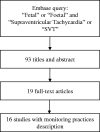Maternal monitoring and safety considerations during antiarrhythmic treatment for fetal supraventricular tachycardia
- PMID: 31217810
- PMCID: PMC6560838
- DOI: 10.1177/1753495X18808118
Maternal monitoring and safety considerations during antiarrhythmic treatment for fetal supraventricular tachycardia
Abstract
Fetal tachycardia is a rare complication during pregnancy. After exclusion of maternal and fetal conditions that can result in a secondary fetal tachycardia, supraventricular tachycardia is the most common cause of a primary sustained fetal tachyarrhythmia. In cases of sustained fetal supraventricular tachycardia, maternal administration of digoxin, flecainide, sotalol, and more rarely amiodarone, is considered. As these medications have the potential to cause significant adverse effects, we sought to examine maternal safety during transplacental treatment of fetal supraventricular tachycardia. In this narrative review we summarize the literature addressing pharmacologic properties, monitoring, and adverse reactions associated with medications most commonly prescribed for transplacental therapy of fetal supraventricular tachycardia. We also describe maternal monitoring practices and adverse events currently reported in the literature. In light of our findings, we provide clinicians with a suggested maternal monitoring protocol aimed at optimizing safety.
Keywords: Fetal arrhythmia; amiodarone; digoxin; fetal supraventricular tachycardia; flecainide; medication safety; pharmacology; sotalol.
Figures
Similar articles
-
Fetal Tachyarrhythmia Management from Digoxin to Amiodarone-A Review.J Clin Med. 2022 Feb 2;11(3):804. doi: 10.3390/jcm11030804. J Clin Med. 2022. PMID: 35160256 Free PMC article. Review.
-
Comparison of transplacental treatment of fetal supraventricular tachyarrhythmias with digoxin, flecainide, and sotalol: results of a nonrandomized multicenter study.Circulation. 2011 Oct 18;124(16):1747-54. doi: 10.1161/CIRCULATIONAHA.111.026120. Epub 2011 Sep 19. Circulation. 2011. PMID: 21931080
-
Antenatal Therapy for Fetal Supraventricular Tachyarrhythmias: Multicenter Trial.J Am Coll Cardiol. 2019 Aug 20;74(7):874-885. doi: 10.1016/j.jacc.2019.06.024. J Am Coll Cardiol. 2019. PMID: 31416531 Clinical Trial.
-
Sotalol as first-line treatment for fetal tachycardia and neonatal follow-up.Ultrasound Obstet Gynecol. 2013 Sep;42(3):285-93. doi: 10.1002/uog.12390. Ultrasound Obstet Gynecol. 2013. PMID: 23303470
-
Sotalol as an effective adjunct therapy in the management of supraventricular tachycardia induced fetal hydrops fetalis.J Neonatal Perinatal Med. 2020;13(2):267-273. doi: 10.3233/NPM-190268. J Neonatal Perinatal Med. 2020. PMID: 31707376 Review.
Cited by
-
Fetal Tachyarrhythmia Management from Digoxin to Amiodarone-A Review.J Clin Med. 2022 Feb 2;11(3):804. doi: 10.3390/jcm11030804. J Clin Med. 2022. PMID: 35160256 Free PMC article. Review.
-
In-Utero Treatment of Fetal SVT: A Case Report.J Obstet Gynaecol India. 2025 Feb;75(1):86-88. doi: 10.1007/s13224-024-01952-2. Epub 2024 Mar 15. J Obstet Gynaecol India. 2025. PMID: 40092378
-
Multiple direct fetal amiodarone administration for supraventricular tachycardia with hydrops fetalis: a case report.Eur Heart J Case Rep. 2023 Mar 23;7(4):ytad128. doi: 10.1093/ehjcr/ytad128. eCollection 2023 Apr. Eur Heart J Case Rep. 2023. PMID: 37057279 Free PMC article.
-
Persistent Fetal SVT in a COVID-19 Positive Pregnancy.Case Rep Obstet Gynecol. 2022 Jan 7;2022:9933520. doi: 10.1155/2022/9933520. eCollection 2022. Case Rep Obstet Gynecol. 2022. PMID: 35013695 Free PMC article.
-
Unexplained fetal tachycardia: A case report.World J Clin Cases. 2024 Mar 26;12(9):1698-1703. doi: 10.12998/wjcc.v12.i9.1698. World J Clin Cases. 2024. PMID: 38576745 Free PMC article.
References
-
- Oudijk MA, Ruskamp JM, Ambachtsheer BE, et al. Drug treatment of fetal tachycardias. Paediatr Drugs 2002; 4: 49–63. - PubMed
-
- Sweha A, Hacker TW, Nuovo J. Interpretation of the electronic fetal heart rate during labor. Am Fam Phys 1999; 59: 2487–2500. - PubMed
-
- Ueda K, Maeno Y, Miyoshi T, et al. The impact of intrauterine treatment on fetal tachycardia: a nationwide survey in Japan. J Matern Fetal Neonatal Med 2017; 31: 2605–2610. - PubMed
-
- Donofrio MT, Moon-Grady AJ, Hornberger LK, et al. Diagnosis and treatment of fetal cardiac disease: a scientific statement from the American Heart Association. Circulation 2014; 129: 2183–2242. - PubMed
Publication types
LinkOut - more resources
Full Text Sources
Research Materials


